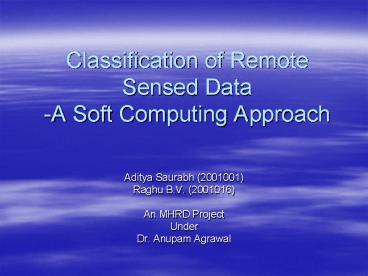Classification of Remote Sensed Data A Soft Computing Approach PowerPoint PPT Presentation
1 / 14
Title: Classification of Remote Sensed Data A Soft Computing Approach
1
Classification of Remote Sensed Data-A Soft
Computing Approach
- Aditya Saurabh (2001001)
- Raghu B.V. (2001016)
- An MHRD Project
- Under
- Dr. Anupam Agrawal
2
What we did?
- Collection of Data
- Satellite Images LISS and PAN
- Preparation of Data
- Image to Map Registration
- Fusion
- PCA
- Classification
- ANN-BP
- GA-BP
- Modular ANN
- Accuracy Assessment
3
Data Preparation
LISS99
PAN99
Register
Register
Map
Map
Registered PAN
Registered LISS
Fuse
4
Classification
LISS Image
Fused Image
Classify
ANN-BP
GA-BP
Modular ANN
5
Accuracy Assessment
Reference Data or Classified Map B
Classified Map A
Accuracy Assessment
Kappa Coefficient
Producers Accuracy
Confusion Matrix
Users Accuracy
Overall Accuracy
6
Back-propagation Network
- It is widely used in the classification of multi
spectral images. - Limitations
- Can be easily trapped into Local Minima.
- Learning rate is slow.
- Huge number of training samples are required.
- Uses gradient descent (Greedy Algorithm). So,
transfer function must be differentiable.
7
GA-BP
- Uses Evolutionary Algorithm for initialization of
weights. - Back-propagation for fine tuning the Neural
Network weights. - Population (wi , n1)
- Selection Process Tournament Selection Scheme.
- Mutation wi Gaussian-Random(0,1)n1
- Fitness Function Ranking on MSE
8
- Advantages
- Evolution Learning Adaptation.
- Probability of reaching global minimum higher.
- Less sensitive to initial weights.
- Disadvantages
- Computationally expensive for small networks.
9
Modular Neural Networks
- Reverse Engineering Biological System.
- Optimal Number of Modules is square root of
classes. - Stages
- Task Decomposition.
- Module Training.
- Multi-Module Decision Making.
Task Decomposition (ART)
Module Training (BP)
Multi-Module Decision Making (Voting Layer
Democracy)
10
(No Transcript)
11
- Advantages
- Cooperation between intelligent workers yields
better capability than summation of Individuals. - Scalability
- Extendibility.
- Competition Cooperation
- Parallelizable.
- Disadvantages
- Computationally Expensive on 1p machine.
12
Papers
- 1 G. Auda, M. Kamel, and H. Raafat. Modular
neural network architectures for classification.
In International Conference on Neural Networks,
volume 2, pages 1279-1284, Washington D.C., June
1996. - 2 G. Bartfai. Hierarchical clustering with ART
neural networks. In World Congress on
Computational Intelligence, volume 2, pages
940-944, Florida, June 1994. - 3 G. Auda, M. Kamel. Cooperative Modular Neural
Network. IEEE, 1997. - 4 XIN YAO. Evolving Artificial Neural Networks.
PROCEEDINGS OF THE IEEE, VOL. 87, NO. 9,
SEPTEMBER 1999.
13
Books
- Computer Processing of Remotely-Sensed Images, An
Introduction, Second Edition, Paul M. Mather.
1999 http//www.geog.nottingham.ac.uk/mather/ - Introductory Digital Image Processing A Remote
Sensing Perspective (2nd Edition) by John R.
Jensen - Machine Vision and Advanced Image Processing in
Remote Sensing by Ioannis Kannellopoulos, Graeme
G. Wilkinson, Theo Moons 1999 - Classification Methods for Remotely Sensed Data
by Brandt Tso and Paul M. Mather 2001
14
Thank YouQuestions?
http//profile.iiita.ac.in/asaurabh_00/MyProjects/
7thSemester/

